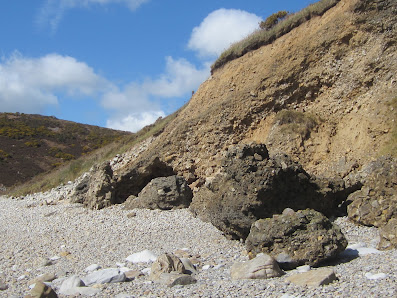This has to be one of the strangest coastal landscapes I have seen anywhere in Wales. At the east end of the Morfa Bychan storm beach, where the cliffline extends out to Gilman Point, there are huge blocks of cemented slope breccia (made of shattered blocks and shards of sandstone and shale) resting on the storm beach. It's difficult to get a sense of scale when you look at them from a distance, but up close they are rather impressive -- up the the size of caravans. I estimate that some of them weigh upwards of 200 tonnes. This is a carbonate-rich environment, with Carboniferous Limestone outcropping at beach level -- so that's where most of the cement has come from. But there also seems to be iron oxide and manganese oxide cement in places. There are some cemented breccia layers outcropping at the base of the breccia cliff face around HWM, but others can be seen more than 10m above HWM in the vast scar that has been cut into the valley slope. The slope breccias are chaotic, formed more through occasional cliff falls and slope collapses than through the slow accumulation of layer after layer. It's difficult to work out any history of sedimentation here, apart from saying that these slope materials have accumulated over many thousands of years. There is no way that this cliff exposure can be tied in to any glacial sequence.
Most of these vast blocks are resting on the beach cobbles, and some have travelled more than 50m from the cliff face. Those most distant from the cliff face have been subjected to some modification by storm waves, and are grey in colour instead of grey-brown to black.
One of the freshest "breccia boulders" (bottom photo) rests on the undulating upper surface of the Carboniferous Limestone beds at the foot of an overhanging sandstone cliff; it has clearly come crashing down from a height of at least 15m.





2 comments:
Did you visit the Gower coast too recently?
No -- I didn't get as far as the Gower. Quite enough to get my teeth into in Morfa Bychan and around Ragwen Point........
Post a Comment